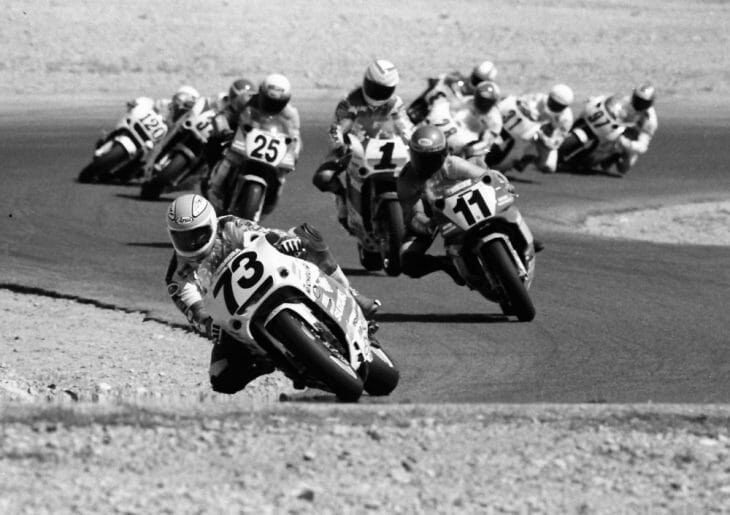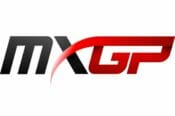
Scott Gray, riding Yoshimura Suzuki’s iconic 172 horsepower ‘Big Papa’ GSX-R1100, gets the jump on the rest of the Formula USA field at Willow Springs Raceway in April of 1990. (Photo by Larry Lawrence)
As the crowd watched Sunday morning practice of the WERA Formula USA National at Willow Spring Raceway in April of 1990, the space shuttle Discovery landed down the road at nearby Edwards Air Force Base. Yet no one was sure that the giant sonic boom which shook Willow Springs generated by the Space Shuttle because it just as easily could have been from “Big Papa” the 1340cc Suzuki GSX-R1100-based beast created by Yoshimura R&D ridden by Willow specialist Scott Gray.
There was a buzz in the air at Willow that day. Gray came out of semi-retirement and Daytona winner David Sadowski was on hand along with his Vance & Hines Yamaha teammate Thomas Stevens, for the opening round of the WERA Formula USA Series. Gray used the stunning power of his Yoshimura Suzuki they nicknamed Big Papa to completely dominate the weekend against an impressive field of riders.
The story of the very first WERA Pro F-USA race was the diversity of equipment used; Formula USA allowed unlimited modifications. Rich Oliver showed up riding a Marlboro TZ250 GP bike; Lee Shierts also elected to go with a 250; Vance & Hines didn’t bother to build a special bike just for this race, opting instead to use their AMA Superbike legal Yamaha OW01 750cc machines. Most of the other entries were big-bore Superbikes with varying stages of modification.
It quickly became obvious during Saturday’s practice that the state of the art in Formula USA machinery was Gray’s bike. The monster GSX-R had enough brute power to pull the 200-plus-pound Gray down the back straight with enough velocity to suck the paint off any bike that happened to be in its path. Sunday morning practice was an indication of things to come, when Gray broke his own track record, turning a 1:25.98 lap. The feat was even more impressive when you consider that the new record was set in winds gusting up to 40 mph.
A top race mechanic for a competing team said he witnessed the Yoshimura machine being dynoed at an astounding 172 horsepower. By comparison, the Team Hammer Formula USA Suzuki GSXR1100s were estimated by builder Keith Perry to make 158 horsepower. With that kind of power, the Yoshimura Formula USA bike was likely the most powerful four-stroke motorcycle ever road raced in this country up to that point.
But to credit Gray’s win entirely to his machinery would be unfair. The racing veteran had to harness that power and put it to good use. To assist Gray in this task, engine was refined with a race close-ratio, dry-clutch transmission, the standard 1100 frame featured with modified swing arm pivots, the bike fitted with the best Michelin slicks, along with Kayaba’s top-of-the-line upside-down forks and rear shock. That combination made Gray’s machine not only the most powerful, but also one of the best-handling machines on the track.
Tire life was a major question for the beast. The previous year’s Formula USA race saw at least one front runner chunk tires, and in the 1990 race several teams were having trouble with chunking tires during the endurance race held the day before the Formula USA Final. Could Gray’s tire hold up under the extreme pressures put on it by the bike’s high horsepower, his relatively heavy weight and his blistering pace during the 20-lap dash?
At Willow, tires are put to the ultimate test. “This track is tougher on tires than any track in the U.S.,” said Dunlop Tire technician Jim Allen. “Even Daytona doesn’t put the continued stress on them like Willow does, and we record the highest tire temperatures seen in the world right here in turn eight”.
On the other end of the spectrum was the Marlboro Yamaha TZ250 ridden by Rich Oliver. During practice, Oliver was second fastest, but that was during runs on an open track. The challenge that faced Oliver was being able to keep that fast pace on a track crowded with Superbikes. “The problem is that I really make time by using the advantage of the light weight and handling of my 250 going into turns. If a Superbike is blocking my way I have no way to get around them,” Oliver explained.
Any doubt that people might have had about Big Papa’s superiority was laid to rest by after the heat races. Gray started from the back row, but still won easily. For everybody else, after the heat races it suddenly seemed like it was a race for second place. Gray’s fastest lap in the second heat was 1:26.18 versus a 1:28.14 by first heat race winner Barry Burke.
The grid was now set for the final. Gray, Burke and Sadowski occupied the front row. On the second row were Kurt Hall and Stevens. Cooley headed up the third row which was rounded out by Curtis Adams and Phil Kress.
At the start of the final Gray grabbed the lead but was closely pursued by Stevens and Sadowski. Hall was in fourth followed by Graves and Cooley. By the fifth lap Gray had a surprisingly small lead (2.5 seconds) over the Stevens/Sadowski battle. Chuck Graves, the previous year’s race winner, moved into fourth five seconds back; then came Burke.
Gray became a blue-and-white blur, turning a 1:26.74, the best time in the race. During the middle stages of the race Gray continued to consolidate his lead, getting as much as a seven-second lead on Stevens and Sadowski.
By the halfway mark, Gray had his biggest lead of the day. Stevens continued to hold a tiny lead over Sadowski. Graves was barely holding off Burke in fourth, and Mike Smith was putting some distance on Oliver.
In the second half of the race the battle between Stevens and Sadowski was heating up and became the center of attention. The two Vance & Hines riders were pushing their bikes through the turns at an unbelievable pace. Watching the duo go through turns eight and nine was amazing, the FZRs running side-by-side with both wheels drifting all the way to the edge of the track. The battle was so intense, that the V&H riders were turning 1:27s and closing on Gray.
Up front Gray spent the closing laps monitoring his lead and preserving his tires. He took the checkered flag and the win 4.6 seconds ahead of Sadowski. It was a sweet victory for Gray, who most people thought was through with racing. Gray was casual about the victory. “I was really riding conservatively out there. I got stuck in some traffic near the end but I knew I had a big enough cushion,” he said.
The victory over the factory-back Yamaha Superbikes, along with the sheer audacity of Yoshimura’s Big Papa caused the machine to become an instant icon. People who were around road racing during that era still talk about the sheer power of Big Papa all these years later.
According to one of Big Papa’s mechanics, Carry Andrew, “The Big Papa project was dissolved and the parts returned to Superbike rotation,” Andrew said. “The original GSX-R1100 was resurrected in street form, then sold.”
